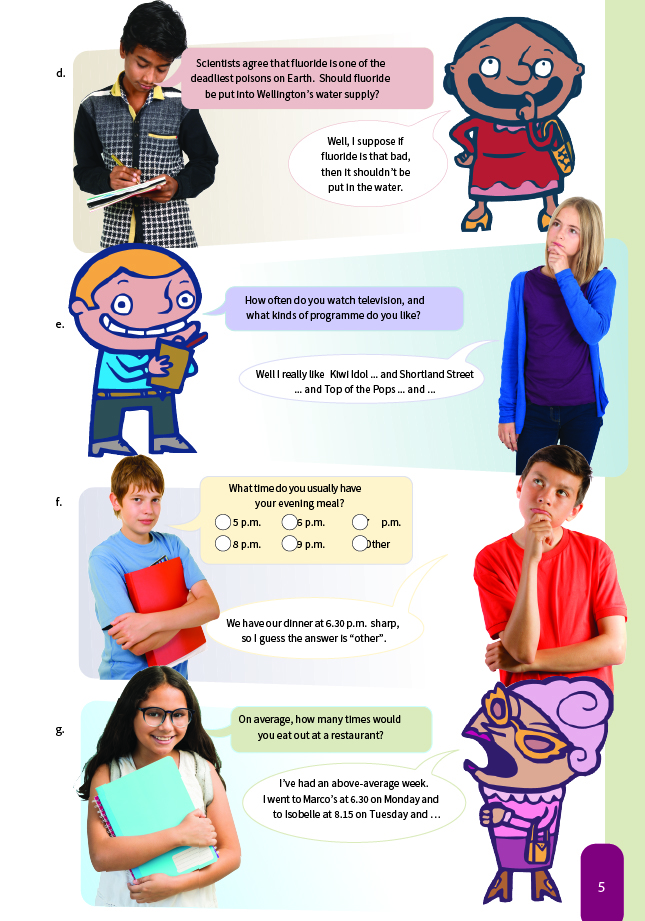This is a level 4 statistics activity from the Figure It Out series.
Click on the image to enlarge it. Click again to close. Download PDF (330 KB)
pose questions suitable for a survey
FIO, Level 4, Statistics, Book One, What's the Question? pages 4-5
This activity asks what makes a good survey question. Students could work on the task in groups. By pooling their different opinions, they will gain a better understanding of the issues involved in writing good questions. They are also more likely to be able to work out the meaning of the specialised language used in some of the examples.
When they have completed this activity, ask your students what they have learned. You may like to collate their ideas by writing on the board a list of things to remember when making up questions for a survey.
The list could include avoiding:
- excessively long questionnaires
- questions that need too much explaining
- long words, specialised language, and abbreviations that people may not understand
- emotive language
- unnecessary use of negatives, especially the use of double negatives
- statements that are vague or that can be understood in more than one way.
The students could look at the kinds of questions asked in surveys. Points for discussion could include:
- Do the questions require unstructured or structured responses? If unstructured, people can respond as they wish. If structured, people are given a number of choices and have to choose which one best fits with their situation or point of view. This kind of item will often also allow for an unplanned answer by including an option such as “other; please state …”. Structured responses are usually much easier to collate, write up, and display.
- What are the different ways in which responses can be structured? These include ticking the box, ranking on a scale, and putting a set of items in order of preference. What is each kind useful for? When thinking about this, the students should consider whether the survey is designed to gather facts or opinions.
- Are the questions intended for a small, well-defined group (such as the members of a church or a club), or are they intended for a much wider and more representative population?
- Do we need to trial surveys? The purpose of trialling is to check that:
– the instructions make sense
– the questions are in a logical order
– the questions make sense
– the categories for structured responses are sensible and cover the possibilities
– the responses people make are useful and meet the purpose of the survey.
As an extension, the students could design and trial a questionnaire on a topic of their choice. This could be written up as a wall display, outlining the process used and the purpose of each of the questions.
Answers to Activity
a. The question is of limited use because it has two possible meanings. Which should be banned, dogs or children? It is also a leading question because “vicious” is an emotive word. Avoid language of this kind.
b. The term “family” is too broad. The surveyor should use another term (like “household”) or define “family”. The surveyor should not suggest that the maximum size of a family is 7.
c. The question contains negatives like “not”, “no”, and “non”. These should be avoided because they are confusing. Even worse is the use of two or more negatives.
d. Scientists can be found to support both sides of the argument. This question tells the person what answer they should be giving. The surveyor should present both sides to the listener.
e. Make this question more specific. The hearer will be unsure what sort of information the surveyor is looking for, and it will be difficult to classify the responses people give.
f. Specify time in intervals (“between 7 and 8 p.m.”) rather than exact times.
g. Sharpen the time interval: “How many times in an average week?” or “How many times in the last 7 days?” or offer categories such as “About once a week” or “More than once a week”.

